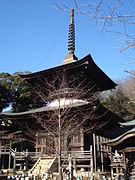Rakuhō-ji
The Rakuhō-ji ( Japanese 楽 法 寺 ), also called Amabiki Kannon ( 雨 引 観 音 ), with the mountain name Amabikisan ( 雨 引 山 ) is a temple of the Buzan branch ( 豊 山 派 Buzan-ha ) of the Shingon branch of Buddhism in Sakuragawa ( Ibaraki Prefecture ), Japan. In the traditional count it is the 24th of the 33 temples in the Kantō region .
history
According to tradition, the temple developed from the residence of the Buddhist scholar Dokushu ( 独守 ) who had returned from China around the year 587 and is therefore one of the very old temples. The temple area is quite large at 30,000 m².
The attachment
You climb up to the temple area and pass the mighty temple gate ( 山門 Sammon ; 1 in the plan), which is here in the form of a tower gate as a Niō gate ( 仁王 門 Niō-mon ), i.e. as a gate with the two temple guards ( Niō ) on the right and left is carried out by the passage. The gate is said to have been built at the request of the 6th Shogun of the Kamakura period , Prince Munetaka . You climb a staircase to the level of the temple complex and then you have the main hall ( 本 堂 Hondō ; 2) in front of you, which has a hipped roof . It comes from the Meireki era (1655–1658). To the left of the main hall is a small, narrow building and next to it the large treasure pagoda ( 多 宝塔 Tahōtō ; 3). This was built in the Kaei era (1848-1854).
Other buildings include the Ema-dō ( 絵 馬 堂 ; 4), the bell tower ( 鐘楼 Shōrō ; 5), the two-story sacrificial kitchen ( 御 供 所 Gokusho ; 6) from the Ansei era (1855-1860) and the hexagonal Rokkaku-do ( 六角 堂 ; 7). Next to the main hall is a red pavilion: it is the shrine dedicated to Tōshō Sannō ( 東 昭 山 王 社 殿 - shaden ; 8). A 70 m long and 13 m high wall (M) made of stone blocks runs under the sacrificial kitchen.
Further back is the abbot and monk's quarters (A) and the guest house for visitors (G).
Temple treasures
The wooden, standing Kannon ( 木造 観 世 音 菩薩 立 像 ), which is traditionally called Emmei-Kannon ( 延命 観 音 ), which means "life- extending Kannon", comes from the early Heian period and has eight arms ( 八 臂 hatsubi ). The Kannon made from one piece of wood is registered as an important cultural asset of Japan . She is here as a saint of esoteric Buddhism ( 密 教 mikkyō ) i. A. not open to the public, but is shown annually on the 1st Sunday in April. In front of her you can see a Kannon as "Vorsteher Kannon" ( 前 立 観 音 Maetate Kannon ).
Other temple treasures are registered as cultural assets of the prefecture. These include the main hall, the treasure pagoda, the Niō gate, the shrine in honor of Tōshō Sannō. Also registered are pictures of the Aizen Myōō ( 愛 染 明王 ), the Benzaiten ( 弁 財 天 ), an eleven-headed Kannon ( 十 一面 観 音 菩薩 ), a sculpture of the Fudō Myōō ( 不 動 明王 ), 490 sutras and Buddhist implements from the Heian Time.
photos
literature
- Ibaraki-ken shiiki-shi kenkyukai (Ed.): Amabiki Kannon . In: Ibaraki-ken no rekishi sampo. Yamakawa Shuppan, 2006. ISBN 978-4-634-24608-9 . P. 137.
Web links
Coordinates: 36 ° 19 ′ 51 ″ N , 140 ° 7 ′ 15 ″ E



